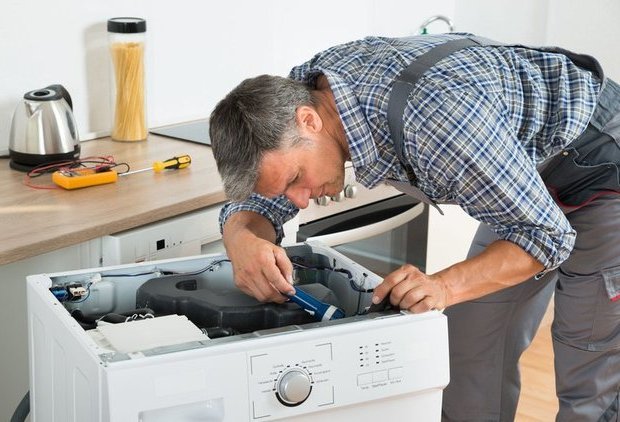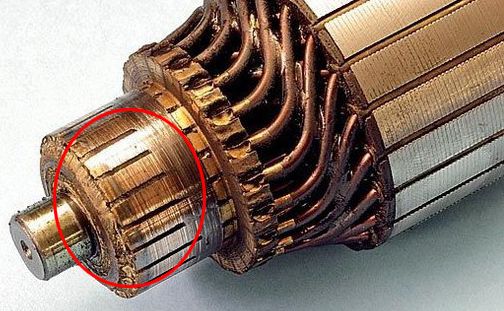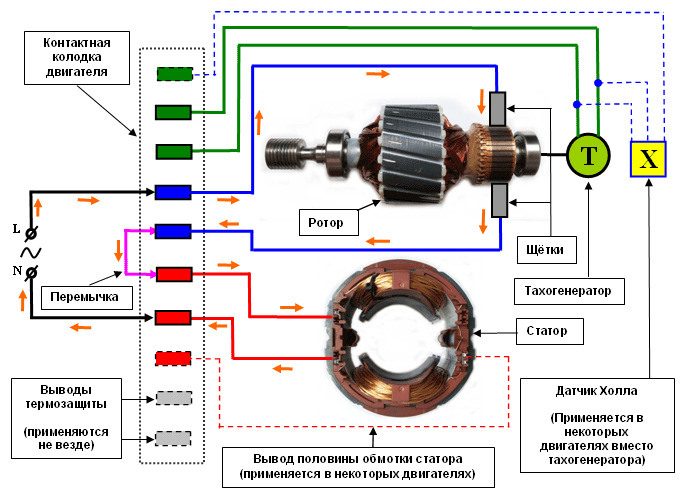Categories: Repair of household appliances
Number of views: 31799
Comments on the article: 0
Typical electrical problems with washing machines
A washing machine is usually bought for many years and is used almost every day. Any modern washing machine belongs to a rather complex technique in which everything is interconnected, including electronic and electromechanical components. The main electrical components are:
-
TEN;
-
Electric motor (drum drive);
-
Drain pump;
-
Group of sensors;
-
Control unit (this may be called a programmer);
-
Mode selector.

Sooner or later, the washing machine is interrupted. Perhaps these are extraneous sounds, or a complete lack of reaction to the programs. The cause of the problems can be both mechanical problems and electrical ones. Here is a short list of mechanical problems:
1. Jamming of the drum with foreign objects.
2. Water does not accumulate because the inlet filter is clogged.
3. The water does not drain because the filter is clogged.
4. Breakage of a driving belt.
5. Stuck pumps.
In this article, I propose to consider some problems of an electrical nature. For work you will need:
-
Multimeter;
-
Jumper set;
-
A set of keys and screwdrivers (some washing machines do not use standard screws, but asterisk type screws and others).

First malfunction: The washing machine does not turn on and does not respond to buttons
If you try to start the washing machine, but nothing happens, you need to make sure that the indicators on the display or the LEDs on the front panel of the washing machine are on. If the indicators are off:
1. Check if there is voltage at the outlet. With an indicator screwdriver, you will only check the presence of a phase, so you need a two-pole voltage indicator or a multimeter in the AC voltage measurement mode. If there is no voltage, we disassemble the socket and see if the wires are intact. If not, you need to look for problems in the wiring, but for now, an extension cord from the nearest working outlet will help you.
2. If there is voltage in the outlet, then you need to check the cord of the washing machine, for this you need to examine the machine from the outside and determine where the wire goes, then you need to disassemble the machine body, in the beginning you can try to remove the top cover, if the wire goes further - you can try put the machine on its side and get to the place of its connection. If this does not help, remove the half of the washing machine. If there is no voltage at the end of the cord that connects to the circuit, then it must be replaced.
3. If the cable turned out to be working, then you need to look for problems in the control unit. First, find the place on the board where the voltage is applied and measure its value. If it is equal to the voltage in the network, then the board is faulty. Check the integrity of the fuse - this will help you dial or a multimeter in its mode.
4. If the fuse is blown - the problem is in the circuit board, the description of the control unit diagnostics is worthy of a series of articles, but if you are poorly versed in electronics repair - you are unlikely to be able to do something. And the rest, a superficial examination of the paths of the board for burnout and parts for damage will help to find the malfunction. Tracks need to be restored and parts replaced. Also, the malfunction may be in the programmer (selector) of the washing machine mode, its contacts may burn out or rot.
This is where the power problems end. If everything is correct, but the machine still does not start, then the problem is in the board, while the power supply is located on it, you can check if there is any voltage at its output (5V or 12V), if there is voltage, the microcontroller or microcircuit may be defective EEPROM memory.
The second malfunction: the machine turns on, but the water does not heat up, the wash is on, either it gives an error, or it does not start
If the water is not heated 90% probability that the problem is in the heater. To check the heater, take a continuity and connect to its terminals, if the continuity does not squeak, it means that the circuit is broken, that is, the heater spiral has burned out. It will not warm and it needs to be replaced, there may also be another problem - the heater hit the body. In this case, you can replace it.
The resistance of the heating element should be about 30 Ohms, on all washing machines it is about the same. The temperature sensor is about 27 kOhm, but this greatly depends on the specific heater model and the washing machine. We published a separate article toak replace the heater.
If the heater is OK, but the water does not heat up, the problem is in the heating circuit. You need to inspect the wiring from the heater to the board, connection contacts and relays. The coil resistance should be around 400 ohms. For diagnostics, you need to ring the power contacts, usually a relay has a normally-closed and a normally-open pair, and the one that is closed should be called. The relay is heavily loaded, because currents up to 10A flow through it.
A detailed algorithm for resolving such a malfunction is shown in the video.
To extend the life of the heater, it is recommended to take measures to reduce the water hardness - use a filter, add special substances to the wash, use a descaler. The more limescale on the heating element, the worse it gives off heat and the faster it burns, moreover, its body is destroyed by scale.

First of all, you need to inspect:
-
drum drive belt;
-
whether the drum itself is mechanically jammed;
-
Is there any difficulty in rotating the motor shaft?
If everything is in order, we proceed to electrical problems. Check if all connectors are connected to the motor, and whether they are intact. If everything is fine, move on. Most often, a collector motor is installed. It is necessary to determine which contacts of the terminal block are responsible for. There may be:
-
Wires from brushes;
-
Wires from the field winding;
-
From the tachometer (speed sensor).
Two wires are coming from the speed sensor. It is located on the opposite end of the motor from the pulley, to determine them on the terminal block, simply trace where the wires go from it. To check the sensor, you need to connect the multimeter probes to the terminals, set the dialing mode on it, some values will be displayed on the screen. If the values began to change during the rotation of the engine, then the sensor is in good condition.
A malfunction of this sensor can lead to the appearance of unstable malfunctions, disruption of the functioning of certain modes, for example, spinning. An example of such a malfunction and its diagnosis is shown in the video.
Next, we examine externally whether the brushes are in place, and in what condition the collector is: whether there is carbon deposits, potholes, scuffing on the lamellas and other things. Brushes can be replaced if they are worn out, if carbon deposits are anchored - it can be cleaned with an eraser. If there are other problems with the anchor, such as teasing or obvious violation of the integrity of the windings or lamellas, it is easier to find a similar anchor than to find a master to restore this.

Back to the terminal block. Using an ohmmeter or dialing, we find connected pairs of contacts. The motor has an excitation winding and anchors, so two contacts should ring each other. In principle, measuring the resistance of the windings without knowing the nominal values does not make much sense. To check its performance, you need to assemble a circuit.
Connect the field winding in series with the armature. You have already determined which terminals “ring” among themselves, i.e. there is a winding between them, so you need to connect one output from each other (you will need a jumper with the “mother” terminal), between the remaining two (one from the brushes, one from the field) supply 220V.

Here is a typical motor start circuit for a washing machine. All items are signed.If the engine runs flawlessly, the last option is the control board. After turning on the engine, it is worthwhile to carefully inspect the brush assembly, there should not be strong sparking and all-round fire.
A short start-up of the engine may not give results in order to visually verify its operability - connect one of the supply wires to the heater or a 500W bulb.
If the motor consumes more than normal current, the light will light up, and the heater will begin to heat up intensely. It is convenient to use the heater; You do not need to take a light bulb with you if you have to work on the road. You can use the heater that heats the water in the washing machine, you only need a couple of jumpers.

Reverse relays are located on the control board. Normal relay with a switching group of contacts. Here is a simplified part of the control unit circuit. There may be a malfunction in the relay, if the relay clicks, this does not mean that it is serviceable. Perhaps his contacts were burnt. It is tiny, the case can be airtight, so it makes no sense to try to repair it, look for a suitable replacement. If you do not find it with the same pinout, you can try to mount the main thing on the wires by mounted mounting, so that the type of contact groups and the permissible current match.

Conclusion
Most of the remaining faults are associated with the operation of the control unit, with electronic components and components. For the basic diagnosis of the above recommendations will be enough. Thanks to this check, you can eliminate most of the problems with washing machines. Most malfunctions can occur due to poor power supply quality. Connect the washing machine through voltage regulator, and you will avoid one of the harmful factors for your assistant.
See also on this topic:How to connect the motor from the washing machine to the 220 V network
See also at bgv.electricianexp.com
:
